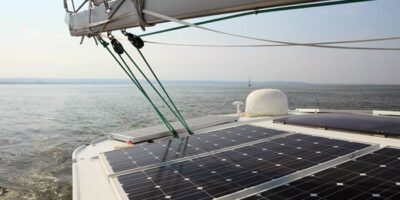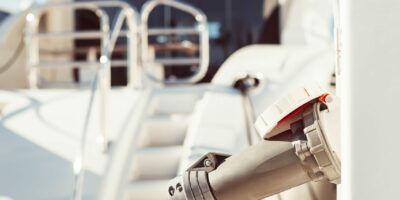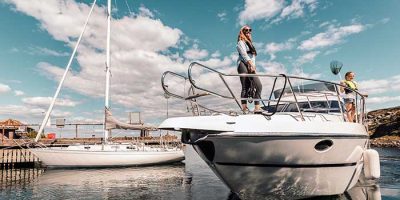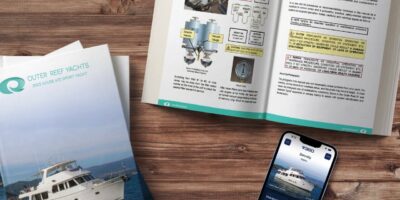Installing A Remote Fuel Filter
Enhance the safeguarding of your motor with added security by incorporating a remote fuel filter, providing an additional layer of protection for your engine.
- January 25, 2024
Your boat needs a remote fuel filter. More specifically, a water-separating, spin-on, remote fuel filter. Inconsistent fuel quality practically mandates this easy-to-install accessory. While it’s not as sexy as a new stereo, it could save your day when your local fuel dock pumps some waterlogged fuel into your tank, and it may even prevent serious engine damage.
More Than Just Gas
The alcohol content in most fuels is 10 percent. Ethanol is the alcohol that’s used in gasoline, and ethanol attracts water. Fuel that sits in your boat’s tank, especially if you don’t use your boat for long periods of time, gathers condensation from temperature and humidity changes that occur every day. To have this water run through your engine’s fuel system and then in its combustion chambers is never a good thing.
Tip: Before buying a filter kit, check the size of your boat’s fuel line and note what type of fuel line you have. While most are rubber, some older and/or larger inboard or diesel engines may have brass or stainless fuel lines, which require different fuelline fittings.
Exacerbating the issue, electronic fuel injection (EFI) and direct fuel injection (DFI or DI) engines are more prone to problems when fuel quality goes down. Two concerns in particular tend to crop up. First, fuel hoses, connectors, injector pintles and tips, as well as carburetor parts like floats, fuel inlet needles, and rubber/plastic parts, are highly susceptible to corrosion and degradation when exposed to alcohol-extended fuels. Fortunately, the engine manufacturers have made good strides in remedying these problems by switching to alcohol-resistant materials in these parts. But keeping water and alcohol to a minimum even in these systems is still best.
Second, EFI and DFI engines are designed and tuned to run leaner to burn less fuel; the same technology that allows them to do this also makes them more finicky when it comes to fuel quality.
These potential problem areas make for a different kind of maintenance today; boaters must be more vigilant about maintaining their boat’s fuel system. A great first step is installing a water-separating fuel filter.
Choosing The Right Filter
These filters are common and available in most marine dealerships, chandleries, online retailers, and big-box stores. You’ll need a kit to perform the installation; the kit consists of the filter canister and mounting system, brass plugs and fittings for the fuel lines, and mounting screws. Many brands and kits are available; two of the best and most common are Racor and Moeller. Both brands are available with clear-sight bowls that allow you to see the water that’s accumulated in the filter over time. Filters with a plastic sightbowl must be mounted outside of the engine space to meet ABYC standards.
Fuel Lines: Time For Replacement?
While you’re buying, consider replacing your fuel lines. If they’re older than 2009, they should be replaced. New fuel line has a tough inner liner that’s more resistant to alcohol damage. The older line had no such inner wall, and the alcohol would literally disintegrate the line from the inside out. Chunks and globs of the inner wall can end up in the engine’s fuel canister and injectors, causing running problems and possible engine failure. If this happens, you’ll have little choice but to pay for a costly injector and fuel system cleaning. Be prepared for some sticker shock if you do replace your hoses; the new EPA-approved line costs about four times more per foot than the older line.
Plan The Installation
Placement should be considered first. The filter should be installed in the outlet line that delivers fuel to the engine, after the tank outlet fitting but before any fuel pumps, regulators, primers or primer bulbs, or other filters. You’ll need to access the canister filter, quite possibly with a filter removal wrench (same as an oil filter removal wrench, available at most auto parts stores) if someone installs the filter too tightly.
Select a location high in the bilge so the assembly never goes underwater. Lastly, consider the hose routing; you want the inlet and outlet hoses to enter and exit smoothly, with no tight radiuses to potentially kink them and cause a fuel restriction. No more than a six-inch radius bend is recommended for rubber-compound fuel lines.
The best place to secure the filter housing is on a bulkhead that allows you to reach both sides. This way you can through-bolt the housing and keep it tight so it won’t vibrate loose. Coat the drilled holes with epoxy resin to keep the wood bulkhead from rotting over time. Use stainless hardware with large flat washers to spread the load, and Nylock nuts so they won’t vibrate loose. Two bolts will secure the housing. The hose fitting threads should be coated with pipe thread sealant (available at hardware and auto parts stores) and tightened carefully; remember, the filter housing is aluminum so cranking the fittings too tightly may cause a crack — one that you may not see until fuel is leaking into the bilge.
Tip: Brass inlet and outlet fittings are available in straight and 90-degree elbow styles to facilitate the best mounting and hose routing layout for your boat.
Before mounting the housing to the boat, install the fittings and the filter. Just like you would with an oil filter on your car, coat the filter gasket with oil before installing it. Spin the filter on and hand-tighten it. Install the filter housing to the bulkhead. Finally, install the fuel hoses to the inlet and outlet sides of the filter housing. Most brands have arrows cast into the ports to ensure that you don’t mix up the hose routing. Most also have dual inlet and outlet ports to handle dual engine installation and/or dual fuel tanks. If you only have one engine and one tank, brass plugs are typically supplied with the kit to block off the unused ports. If you do have dual engines, they can both be run from one filter; if they are larger engines, however, consider running dual filters.
Use quality stainless-steel hose clamps to secure the fuel lines to the inlet and outlet fittings. As you tighten the clamp screw, watch as the rubber fuel line begins to bulge through the serrations on the clamp. That’s tight enough.
Keep An Eye On Things
If your filter has a sight glass, it should be checked frequently for water and contaminants, and emptied before it gets too full. Regardless, the filter should be changed at least once per season; for those who use their boats frequently, twice per season is good preventive maintenance. The filter canisters are not expensive, and it’s a five-minute job even with a filter wrench.
Additionally, you can install a vacuum gauge or fuel-flow sensor to help indicate a clogged filter before it becomes a hazard. A vacuum sensor fitted in the fuel line and gauge mounted on the dash will tell the operator if a fuel system problem has occurred; a hole or cut in the line, a flattened or kinked/crimped line, or a blockage — these maladies will all show up on a vacuum gauge. Even better is a fuel-flow sensor with warning light and buzzer. The warning buzzer and light may be a better signal than checking a gauge, especially in a fast boat or one with a busy dashboard. Both sensors should be installed in the fuel-delivery line to the engine, as close to the engine connection as possible.
John Tiger
Contributor, BoatUS Magazine
About Vessel Vanguard
Vessel Vanguard is a leading marine safety and maintenance management software provider dedicated to revolutionizing the maritime industry. With a commitment to innovation and excellence, Vessel Vanguard delivers cutting-edge solutions to streamline operations and enhance vessel performance and safety.
Latest Industry Insights

Embracing E-Boating Efficiencies

Boat Fuel Systems

The Future of Boats & Boating

Yacht Navigation Light Inspection
View All of Our Industry Insights
Navigate maritime with the latest news, practical how-to guides, insightful analyses and more.
